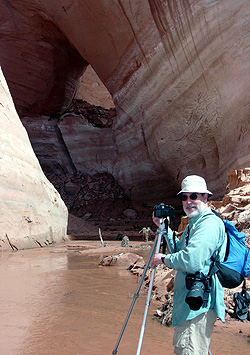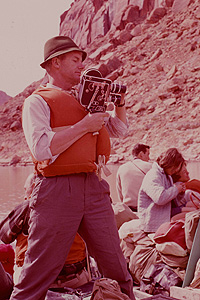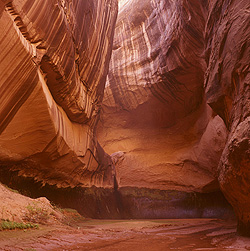Berkeleyan
 Two views of the Cathedral in the Desert, before Glen Canyon was submerged under Lake Powell in the mid-1960s. Years of drought in the Colorado Basin had significantly lowered the water levels, however briefly, by last spring. (Richard Norgaard photos) |
Return to a lost world of 'upside-down mountains'
Rather than fight to restore Glen Canyon, Richard Norgaard teaches students to see the big picture
![]()
| 22 September 2005
David Brower's first encounter with Glen Canyon, in the summer of 1962, changed him forever. The Berkeley-based mountaineer, then the Sierra Club's executive director, had effectively signed a death warrant for the obscure southern-Utah canyon - promising not to block a dam that would flood it if the federal government agreed to drop plans for two others upstream in the popular Dinosaur National Monument. Brower was shaken to see the majestic, Colorado River-sculpted wilderness at the heart of the compromise. He spent his remaining four decades mourning the loss of what he famously called "the place no one knew" and organizing to halt the sacrifice of natural treasures in the name of progress.
 Richard Norgaard last spring at Davis Gulch, in a Glen Canyon made temporarily hikable by reduced water levels at Lake Powell. He is standing on 30 to 40 feet of reservoir silt deposited over the decades. (Nancy Rader photo) |
"Glen Canyon made me realize I wanted to do something at a bigger level than just being an environmental economist," he says, bemoaning the field's narrow, "emergency room" orientation. Destroying the Glen, he explains, is "a part of what we're doing to ourselves - you know, one dam at a time we're losing nature, one language at a time we're losing cultural diversity."
The intimate, richly textured sandstone canyon has been largely submerged since the mid-1960s, when it began its metamorphosis into Lake Powell, a mecca for jetskiers and motorboat enthusiasts. (Conservationists have dubbed it "Lake Foul.") Most of its myriad side canyons, along with such spectacular features as the Cathedral and Rainbow Bridge, have continued to live only in the memories of the relative handful of people fortunate enough to have seen them before they went under.
 David Brower adjusts his Bolex camera as he rafts down the Glen in June 1962.(Richard Norgaard photo) |
For Norgaard, returning after 40 years was "very, very difficult."
"You're recapping your whole life," he says, attempting to describe the depth of his emotions from the shade of the Faculty Club's patio. "You're really thinking, where did this send me, and who am I now that I look back and see this whole thing again?" Being there made Norgaard weep, as much for the fate of the world as for the canyon itself.
"All of us [at the Glen] knew that it's happening all the time, there are other people and other places that are being radically transformed," he says. "It's not just destruction of incredibly beautiful places, but [also] cultural places. And that thought was going through us: what else could we be if we didn't have to keep destroying, and could really think about what progress is and then try to get a better life."
Norgaard has been thinking and writing about progress for much of his career, albeit from an unconventional, cross-disciplinary perspective. He views his two years in Brazil, a period marked by a near-fatal bout with kidney failure at the age of 35, as a touchstone in his intellectual growth. It was then that he realized development results not from design - intelligent or otherwise - but from a complex process of "co-evolution between knowledge systems, value systems, institutional systems, social organizations, technological systems, and the environment."
His refusal to stay inside the lines of accepted models, he adds, helps explain why his 1994 book, Development Betrayed, is better known by sociologists than economists, and why his travels through academia have been, by his own admission, a bit on the rocky side. "It's a lot about why I'm so different from other academics," he says. "Because I'm motivated from a particularly deep place - it's about the whole thing, rather than just trying to be an engineer who's a little more environmental, or a sociologist who can think a little bit about the environment. . There's this bigger picture, which a lot of my life has been about."
 The Cathedral in the Desert before the canyon became submerged under Lake Powell. (Richard Norgaard photo) |
Norgaard, an accomplished amateur photographer whose portfolio brims with studies of the Cathedral, is keenly aware of the damage it's sustained during 40 years as a boaters' playground. But he also marvels at its resilience.
"Even people who go there now that it's been unflooded have a sense that this structure is incredible," Norgaard says, speaking as though the waters haven't risen again. "It is a cathedral. It's a massive opening in an otherwise fairly tight canyon, but then it closes at its top. And so at the top you're just getting a slit of light, and you're looking 400 feet up to this slit of light, and you're in this big hollowed-out space with a 40- to 60-foot waterfall trickling down - it's just trickling, but it trickles into a lake, and it makes a sound that reverberates throughout the whole Cathedral."
"I came back with photographs and showed them to my environmentally oriented, highly educated colleagues, and they'd say, 'Wow, that's really beautiful, it's hardly been affected by the lake at all,'" he laughs, a bit sardonically. "And you know, there's no green in the pictures, but the canyon and the sinuous features and the curves and the sensuousness are still all there - except for the 40 feet that's filled up with silt. . Imagine flooding Yosemite Valley for 40 years and then draining it. All the trees would be gone, all the vegetation would be gone, there'd be silt everywhere, but it would be spectacular. It would be absolutely spectacular. That's what we're dealing with."
Norgaard believes the Cathedral could reclaim its former glory in as few as 15 years, or perhaps a century - depending on the frequency and location of flash floods - if authorities could be persuaded to drain the lake. But he's not actively joining environmental activists who are pushing for Glen Canyon Dam to be opened or torn down completely.
"There is constant temptation to join a fight," he says. "But writing on how scientists themselves have to collectively understand complex systems, and how that's going to open doors to a different conception of democracy, is something that I'm now more motivated by.
"My personal take is that these are the things we plead for to keep people thinking, to keep their consciousness up, to keep the next dam from being built, and in the faint possibility that the event will actually occur," he adds. "But that's my whole philosophy of life. I teach each student in the hope that with the right combination of students, under the right circumstances, things will click and we'll be in a different world."

